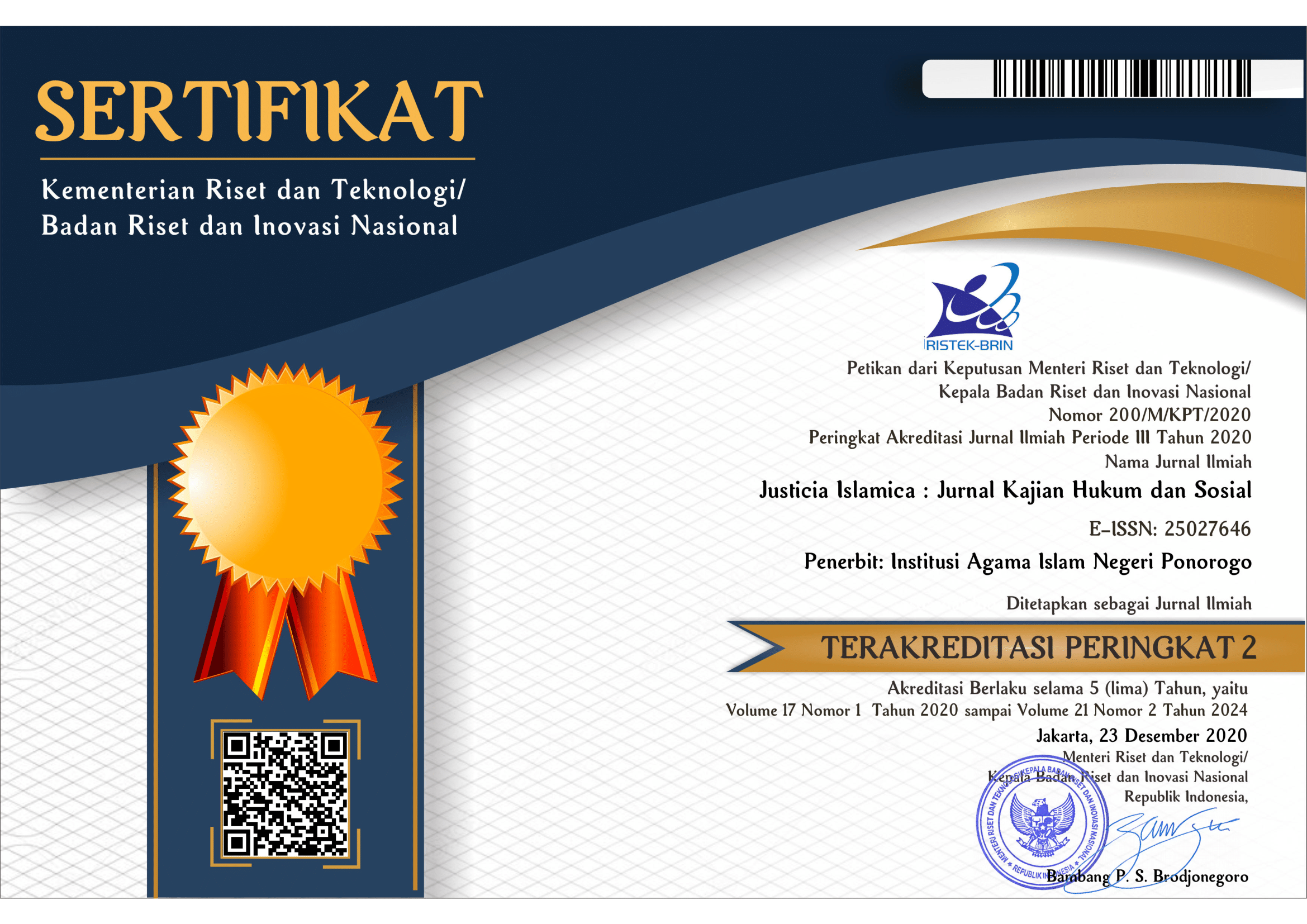Exploring Islamic Law and Customary Law: The Saro-saro Tradition and the Prohibition of the Hijab in Marriage in the Jailolo Muslim Community, West Halmahera
DOI:
https://doi.org/10.21154/justicia.v20i2.6287Keywords:
Saro-saro, traditional symbol, prohibition of hijab, Wedding, JailoloAbstract
This article explores the Saro-saro tradition in the marriage of the Jailolo Muslim Society. In this tradition, traditional symbols should be obeyed, such as the use of conventional clothing, a headscarf bun as a standard symbol, and the prohibition of wearing hijab. This research is qualitative research with an ethnographic approach. Research findings show the ban on head coverings or hijabs and the use of buns as a symbol of tradition, even though they wear hijabs daily. The obligation to wear a bun rule out the obligation to wear a hijab for a Muslim woman at a wedding. Implementing saro-saro is a traditional ritual classified as mubah (allowed) to be applied; merely the conventional symbol, which needs a bun for saro for those who wear hijab, is contrary to Islamic law. When the traditional provision and Islamic law provisions are contradictory, it is a must to negotiate and dialogue then preempt the main requirements on the philosophy of "adat matoto agama, agama matoto kitabullah, and Sunnah Rasulullah," so the tradition and Islamic law can get along in harmony.
References
Ahmad Ibn Muhammad al-Zarq, Syarh Qawaid al-Fiqhiyyah Damaskus: Daar al-Qalam, 1996.
Amir Syarifuddin, Hukum Perkawinan Islam di Indonesia Antara Fiqh Munakahat danUndang-Undang Perkawinan, Jakarta: Kencana, 2006.
-------------------, Hukum Perkawinan Islam di Indonesia, Jakarta: Kencana, 2006.
-------------------, Ushul Fiqh 2, Jakarta: Kencana Prenada Media Group, 2011.
BPS Kab. Halmahera Barat, “Halmahera Barat dalam angka”, https://halbarkab.bps.go.id.html, diakses pada tanggal 15 November 2022.
Eva Diah Ardiani dan Ahmad Musonnif. Integrasi Adat Dan Syariah: (Tinjauan Atas Makna Relijius dalam Tradisi Pasang Bundel dalam Perkawinan Masyarakat Desa Besole Kecamatan Besuki Kabupaten Tulungagung Jawa Timur). Jurnal Al-Ahkam Hukum Islam. IAIN Tulung Agung. 2022.
Firdaus M.Ag, Ushul fiqih (metode mengkaji dan memahami hukum islam secara komprehensif), Jakarta, Zikrul Hakim, 2004.
Fista Dewanti dan Dina Refanda, Statistik Kesejahteraan Rakyat 2022, (Badan pusat statistik kabupaten Halmahera Barat).
Ibn Hajar, Bulughul Maram, diterjemahkan Irfan Maulana Hakim, Bandung: PT. Mizan Pustaka, 2010.
Jawari Tontori, (pengaturan masyarakat hukum adat dan implementasi perlindungan hak-hak tradisional), Pandecta. Vol. 10, nomor 1, juni 2015.
Lili Herawati Parapat, Khatib Lubis, dan Rahmat Huda. Jurnal Penelitian Pendidikan Bahasa dan Sastra. Universitas Muhammadiyah Tapanuli Selatan. Vol. VII, No 1. 2022.
M. Nipan Abdul Halim. Membahagiakan Istri Sejak Malam Pertama. Yogyakarta: Mitra Pustaka, 1999.
Mawardi Muzamil, Anis Mashdurohatun, perbandingan system hukum (hukum barat, adat dan islam), Semarang, Madina Semarang, 2014.
Sitnawati Abd. Majid. Tradisi dalam Pernikahan Masyarakat Ternate di Kota Ternate 1999-2016. Jurnal al-Ahkam. Universitas Negeri Makassar. 2017.
Slamet Abidin et al, Fiqih Munakahat 1, Bandung: CV Purtaka Setia, 1999.
Syarifuddin. Nilai-Nilai Etis Adat Perkawinan Masyarakat Aceh. Tesis. Yogyakarta: Universitas Gadjah Mada, 2003.
Nur Azizah Rahman, Marwa Anjamil Tarima, Harun Ginoni, dan Muhrim Djakat. Telaah Konsep al-Adah al-Muhakkamah pada Tradisi “batal wudhu” Pernikahan Adat Masyarakat Kota Ternate. Jurnal Ilmiah Al-Syir’ah Vol.20, No. I, 2022.
Tuntunan Praktis Rumah Tangga Bahagia, (Badan Penasihat, Pembinaan dan Pelestarian Perkawinan BP4: Provinsi Jawa Timur).
Umi Hidayati. Makan Saro: Doa dan Harapan Pengantin Baru. (Maluku: BNPB Maluku, 2021).
Vinsentius Edo Ari Sadewo, Fatmawati, Riama Al Hidayah. Analisis Makna dan Nilai Simbolik Adat Pernikahan pada Etnis Dayak Uud Danum Buntut Pimpin. Program Studi Pendidikan Sosiologi FKIP UNTAN Pontianak. Volume 11 Nomor 7 (2022): Juli 2022.
Downloads
Published
Issue
Section
License
Requirements to be met by the author as follows:
- Author storing copyright and grant the journal right of first publication manuscripts simultaneously with licensed under the CC BY-SA allows others to share the work with a statement of the work's authorship and initial publication in this journal.
Authors can enter into the preparation of additional contractual separately for the non-exclusive distribution of a decadent version of the journal issue (e.g., post it to an institutional repository or publish it in a book), with the recognition of initial publication in this journal.
Authors are allowed and encouraged to post their work online (e.g., in institutional repositories or on their website) before and during the submission process because it can lead to productive exchanges and citations earlier and more severe than published works. (see The Effect of Open Access).
This work is licensed under CC BY-SA.


















